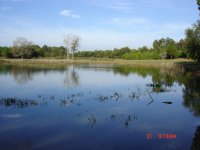You are using an out of date browser. It may not display this or other websites correctly.
You should upgrade or use an alternative browser.
You should upgrade or use an alternative browser.
Pond re-do Part 2
- Thread starter Barton
- Start date
- Views: 9150
/ Pond re-do Part 2
#31
Jim, I just wish Mother Nature would spread that rain out. It will interesting to see how the water level holds this summer. Yes, those were fire ants.
The main reason for burning the hardwood bottoms is, indeed, to reduce the amount of fuel in case of a wild fire. But this year the conditions were not conducive for burning the bottoms because of the moisture content of the oak leaves and, in a large area of the bottoms, there was standing water.
Prescribed burning of the longleaf pines not only reduces the fuel but, also helps control or kill woody brush. In our locale, native gall berry, wax myrtle, oak, and blackberry would soon take over the longleaf pine fields, at least until the pines provided a dense enough canopy to choke out some of the undesirables. The burn does not completely kill the blackberries but it sure slows them down and if the other woody brush is to large they will survive also. A burn should be scheduled every 3-4 years to not only kill new woody brush, but also, to ensure that there is not to much fuel (dead grass and pine needles) on the ground. To much fuel will create to much heat for the pines.
This was the second burn since my daughter bought the property. The previous owner went too long without a burn so a lot of the woody growth survived the first burn. My SIL and I spent a couple of days spraying the woody growth with Remedy. Last Thursday I did notice that there was a section of the west field that had a lot of wax myrtle so we will have to do some more spraying. The next burn should be even better.
It was interesting to learn about the longleaf pine/wiregrass ecosystem which once covered 90 million acres here in the south from Virginia to Texas. The longleaf pines and wiregrass evolved together with fire. Wiregrass will not propagate unless it's burned during its growing season. There is some wiregrass on the property but it will take a lot of effort to get it established through out the pines. I transplanted some clumps to my yard just to see if I could get it to go to seed and then use the seed on my daughter's property.
I have rambled enough. I'll attached a couple of my favorite pictures taken in the hardwood bottoms. The sand was deposited over many years of high water events. The habitat within the bottoms varies so it all doesn't look like this.
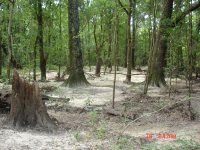
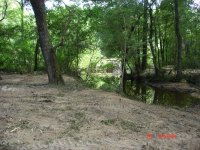
CRBR, you are welcome.
The main reason for burning the hardwood bottoms is, indeed, to reduce the amount of fuel in case of a wild fire. But this year the conditions were not conducive for burning the bottoms because of the moisture content of the oak leaves and, in a large area of the bottoms, there was standing water.
Prescribed burning of the longleaf pines not only reduces the fuel but, also helps control or kill woody brush. In our locale, native gall berry, wax myrtle, oak, and blackberry would soon take over the longleaf pine fields, at least until the pines provided a dense enough canopy to choke out some of the undesirables. The burn does not completely kill the blackberries but it sure slows them down and if the other woody brush is to large they will survive also. A burn should be scheduled every 3-4 years to not only kill new woody brush, but also, to ensure that there is not to much fuel (dead grass and pine needles) on the ground. To much fuel will create to much heat for the pines.
This was the second burn since my daughter bought the property. The previous owner went too long without a burn so a lot of the woody growth survived the first burn. My SIL and I spent a couple of days spraying the woody growth with Remedy. Last Thursday I did notice that there was a section of the west field that had a lot of wax myrtle so we will have to do some more spraying. The next burn should be even better.
It was interesting to learn about the longleaf pine/wiregrass ecosystem which once covered 90 million acres here in the south from Virginia to Texas. The longleaf pines and wiregrass evolved together with fire. Wiregrass will not propagate unless it's burned during its growing season. There is some wiregrass on the property but it will take a lot of effort to get it established through out the pines. I transplanted some clumps to my yard just to see if I could get it to go to seed and then use the seed on my daughter's property.
I have rambled enough. I'll attached a couple of my favorite pictures taken in the hardwood bottoms. The sand was deposited over many years of high water events. The habitat within the bottoms varies so it all doesn't look like this.


CRBR, you are welcome.
Pond re-stocking update:
I submitted an application to the Georgia DNR for the purchasing of fish. I was notified to pick up the fish last week. The DNR sells fish based on size of an unmanaged pond at the rate of 400 bluegill and 100 redear sunfish per acre. The fee is $60. / acre which includes 50/acre large month bass to be picked up sometime next spring.
I arrived at the Steve Cocke Fish Hatchery a few minutes before 8, was loaded and on the road by 10 after.
The instructions from the DNR is to exchange the container water with pond water at the rate of one third every 10 minutes. This is done so the fish can adjust to the pond water temperature and chemical difference without going into shock. I exchanged 4 times 15 minutes apart since I had plenty of time.
The survival rate was excellent; probably 99+%. This was the first time I did something like this so it was a learning/enjoyable experience.
I've attached a few pictures.
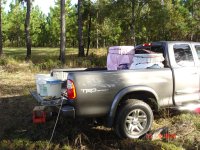
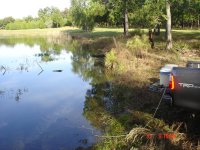


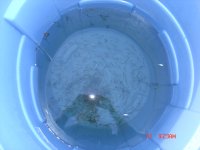
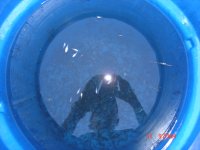
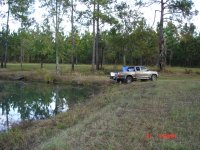
I submitted an application to the Georgia DNR for the purchasing of fish. I was notified to pick up the fish last week. The DNR sells fish based on size of an unmanaged pond at the rate of 400 bluegill and 100 redear sunfish per acre. The fee is $60. / acre which includes 50/acre large month bass to be picked up sometime next spring.
I arrived at the Steve Cocke Fish Hatchery a few minutes before 8, was loaded and on the road by 10 after.
The instructions from the DNR is to exchange the container water with pond water at the rate of one third every 10 minutes. This is done so the fish can adjust to the pond water temperature and chemical difference without going into shock. I exchanged 4 times 15 minutes apart since I had plenty of time.
The survival rate was excellent; probably 99+%. This was the first time I did something like this so it was a learning/enjoyable experience.
I've attached a few pictures.







Attachments
jinman
Rest in Peace
- Joined
- Feb 23, 2001
- Messages
- 20,387
- Location
- Texas - Wise County - Sunset
- Tractor
- NHTC45D, NH LB75B, Ford Jubilee
Bart, that looks like a terrific habitat for fish/minnows. I see no reason that you won't have the maximum survival . . . unless the blue herons discover your newly opened buffet.
EddieWalker
Epic Contributor
You pond is looking great!!! When I stocked mine, I think I went with something closer to 1,000 bluegill per acre and a whole lot more of the fathead minnows. Looking back, I don't think I needed that many because the breed so quickly that a year later they where everywhere.
Eddie
Eddie
Jim, I've seen blue herons and several other types (wood storks, little green heron, cormorants, etc) of water birds in the old pond. Greg said there is a good size flock of ducks that now come in to the pond every evening. I believe the banks are steep enough and the pond deep enough that the fish eating water birds won't get to many.
The emergency overflow spillway, where I parked the pickup, is the only area where there is a gradual slope.
I'm a bit surprised about the amount of weeds that are still alive growing next to the banks. For now the weeds will provide underwater structure for the fish (I guess). Also, there is a pretty good size area of dead weeds still standing toward the north side of the pond that will provide cover.
Eddie, Perhaps the difference in number of fish to stock is that this pond will be unmanaged, at least for a few more years. I forgot to mentioned that the hatchery guys said they gave me a few more red ears because they were having problems with them. They, also said they accidentally gave me a quarter pound extra of bluegills.
Thanks for the compliments guys. Seems like this has been a long process but in scheme of things not really. I am, and I'm sure Tony is, looking forward to fishing in the pond again. I have no idea how long that will be. Anybody have a feel for how long it will be, assuming the pond is as good a habitat as it looks, for the brim and LMB to grow to catchable size?
Michele and Tony are driving down for Thanksgiving. I am going to suggest that we get a few grass carp for the pond. There are a couple of commercial hatcheries nearby that should have them.
Y'all take care.
The emergency overflow spillway, where I parked the pickup, is the only area where there is a gradual slope.
I'm a bit surprised about the amount of weeds that are still alive growing next to the banks. For now the weeds will provide underwater structure for the fish (I guess). Also, there is a pretty good size area of dead weeds still standing toward the north side of the pond that will provide cover.
Eddie, Perhaps the difference in number of fish to stock is that this pond will be unmanaged, at least for a few more years. I forgot to mentioned that the hatchery guys said they gave me a few more red ears because they were having problems with them. They, also said they accidentally gave me a quarter pound extra of bluegills.
Thanks for the compliments guys. Seems like this has been a long process but in scheme of things not really. I am, and I'm sure Tony is, looking forward to fishing in the pond again. I have no idea how long that will be. Anybody have a feel for how long it will be, assuming the pond is as good a habitat as it looks, for the brim and LMB to grow to catchable size?
Michele and Tony are driving down for Thanksgiving. I am going to suggest that we get a few grass carp for the pond. There are a couple of commercial hatcheries nearby that should have them.
Y'all take care.
jimmyj
Elite Member
- Joined
- Aug 28, 2007
- Messages
- 3,719
- Location
- Ontario Canada
- Tractor
- Allis Chalmers 616 (Two) and a Kioti CK30 HST with loader and backhoe
Just saw this thread and I have to say your pond project is absolutely fantastic! I just love what you have done there. You and your family and friends are going to have fun times!
ericher69
Veteran Member
Barton, 5 years should give you decent size fish for angling! I would not introduce grass carp.
From an MNR website
Impacts: Their herbivorous feeding can dramatically reduce aquatic vegetation and they can harm water quality by increasing phosphorus levels.
From an MNR website
Impacts: Their herbivorous feeding can dramatically reduce aquatic vegetation and they can harm water quality by increasing phosphorus levels.
Jimmy, Thanks for the compliment. Michele and Tony both work in the RV Industry in Northern Indiana. I think they plan on retiring to the property in 3 - 4 years. It will be an interesting journey to watch and, hopefully, help a bit. They plan to build a barn first after they have selected a home site. Then build the home and start buying some equipment. :cool2: I believe they will want a couple of tractors with cab and FOPS. Like this (but not necessarily that size):
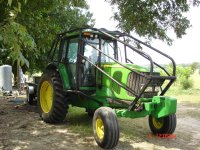
Ericher69, Thanks for the answer and the 'heads up' about the grass carp. I have read some more the last couple of days and you are right; one shouldn't arbitrarily add grass carp. I do know that here in GA only sterilized grass carp can be sold. But I also read that sometimes sterilized carp aren't really sterilized. Also, they have to have moving water to reproduce. If grass carp where to be introduced to the pond it would only be a couple per acre. I will do more research and ask for some opinions from the GA DNR, etc.
Y'all take care out there.

Ericher69, Thanks for the answer and the 'heads up' about the grass carp. I have read some more the last couple of days and you are right; one shouldn't arbitrarily add grass carp. I do know that here in GA only sterilized grass carp can be sold. But I also read that sometimes sterilized carp aren't really sterilized. Also, they have to have moving water to reproduce. If grass carp where to be introduced to the pond it would only be a couple per acre. I will do more research and ask for some opinions from the GA DNR, etc.
Y'all take care out there.
SPIKER
Elite Member
I believe that the Bluegill and other Bream will be of eating size in less than 3 years with good food. the Bass also can be fun catching size in 3rd summer.
Pond looks great, I'm jealous! lol
Mark
Pond looks great, I'm jealous! lol
Mark
